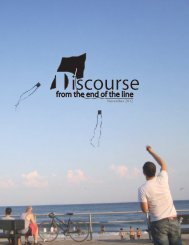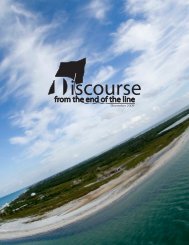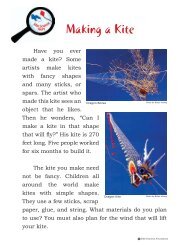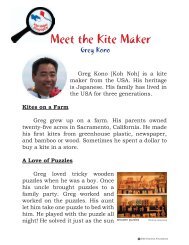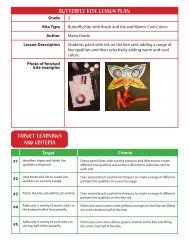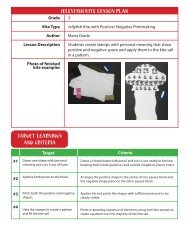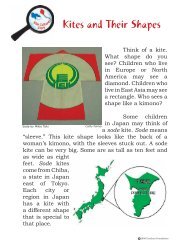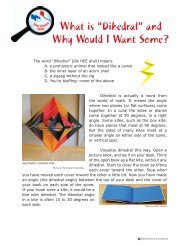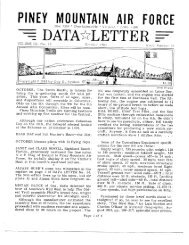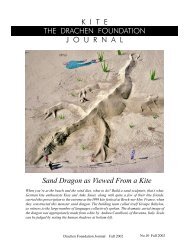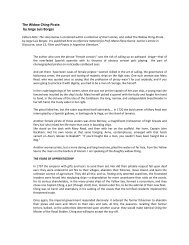Discourse Issue 9.pdf - Drachen Foundation
Discourse Issue 9.pdf - Drachen Foundation
Discourse Issue 9.pdf - Drachen Foundation
Create successful ePaper yourself
Turn your PDF publications into a flip-book with our unique Google optimized e-Paper software.
Generator Locations<br />
Generators are used to convert the motion<br />
produced by the wind to electrical energy.<br />
These generators can be carried on board<br />
the flying device or located on the ground.<br />
Flight Path<br />
The flight path of the various designs differ<br />
in two ways: “reeling out/reeling in”<br />
motion, and “cross-wind” flying motion.<br />
The devices with on-board generators can<br />
be reeled out to the working altitude where<br />
they operate for extended periods, from<br />
hours to days or hopefully longer. They are<br />
then reeled in in response to weather<br />
conditions, maintenance, etc. Devices with<br />
ground based generators use a yo-yo type of<br />
motion to collect energy. As the wind pulls<br />
these devices out, the tether spins the<br />
ground based generator, which produces<br />
power. Some of this power is then used to<br />
reel the device back in. The process is<br />
repeated for the duration of the energy<br />
harvest period.!<br />
The second flight path used is called “crosswind”<br />
flying. Cross-wind flying is a<br />
technique to increase the power output<br />
when flying. As the lifting device is flown<br />
across the wind, the apparent wind (the<br />
wind flowing over the wing) is moving faster<br />
than the ambient wind speed. Since the<br />
power generated by the wing increases as<br />
the cube of the wind speed, cross-wind<br />
flying can greatly increase the power output<br />
of the flying device. For example, using the<br />
cross-wind flying technique to double wind<br />
speed increases the power eight times!<br />
REFLECTIONS ON THE CONFERENCE<br />
DAVE LANG<br />
It is indeed exciting to be aware of, and<br />
involved in, the new potential industry we<br />
refer to as Airborne Wind Energy (AWE). It is<br />
particularly charming that it has been<br />
spawned by, and some AWE incarnations<br />
may well feature, wind harvesting that<br />
utilizes the age-old kite. However, that said,<br />
there are many other ways being proposed<br />
to accomplish AWE harvesting, and the<br />
ultimate winners are yet to emerge. More<br />
specifically, AWE transcends “soft kites,”<br />
and now employs schemes that use “wings”<br />
or “lifting rotors” carrying aloft wind<br />
turbines, which themselves (being rotors)<br />
can become involved with not only<br />
electrical generation, but also in producing<br />
useful lift. Most combinations of the above<br />
are now being examined actively.<br />
When it gets down to brass tacks, AWE is a<br />
highly technical field, because we find<br />
ourselves using aeronautical schemes, wind<br />
turbine technology, high-tech materials,<br />
meteorology, and abstruse analyses required<br />
to not only simulate flight and control<br />
dynamics of tethered lifting devices, but<br />
also to arrive at meaningful estimates of<br />
yearly power production that rigorously<br />
factors in the statistics of wind. As in other<br />
fields of intense scientific/engineering<br />
endeavor, these technical challenges of<br />
course lead folks to want to congregate and<br />
consort with one another to discuss<br />
methods and findings.<br />
So, as all new industries are inclined to do,<br />
the periodic “gathering of the clan” (i.e.<br />
industry conference) is a ceremony of<br />
importance since it brings folks of like mind<br />
together to jovially stimulate and ridicule,<br />
encourage and criticize one another<br />
towards their mutual goal. I have now<br />
attended all three conferences in the US<br />
related to this emerging field of AWE. First,<br />
there was the 2006 Kite Sailing Symposium<br />
sponsored by the <strong>Drachen</strong> <strong>Foundation</strong><br />
(possibly the “original” AWE conference,<br />
since many attendees were there to<br />
exchange information on traction kite<br />
technology as it might apply to wind power<br />
36





